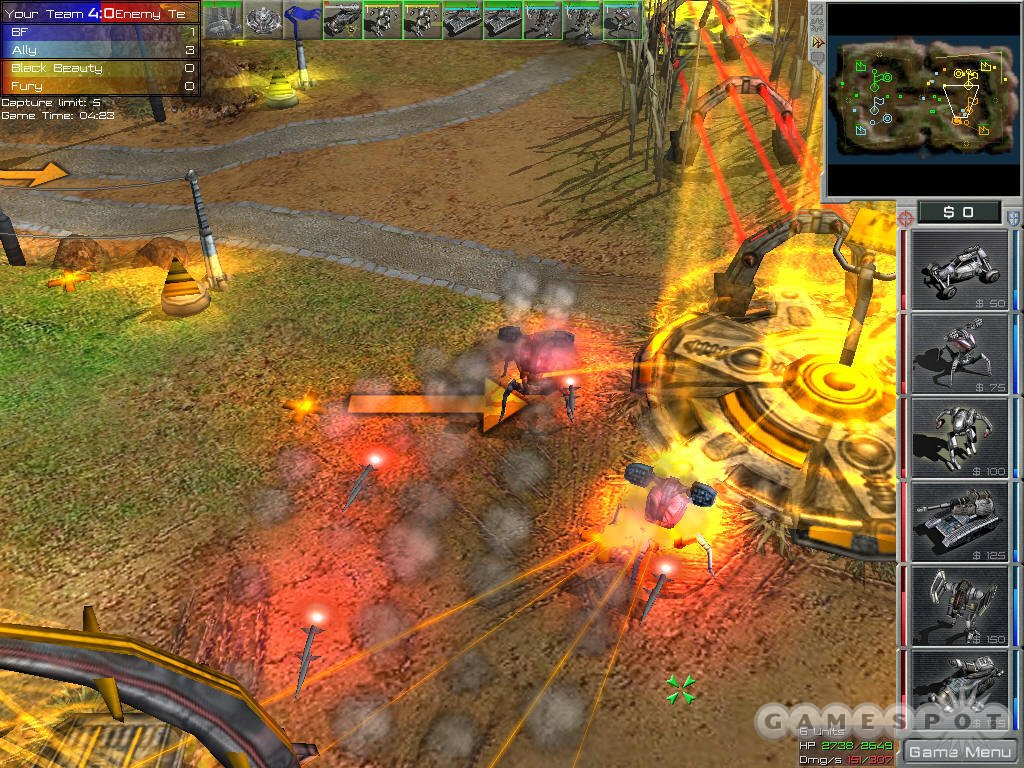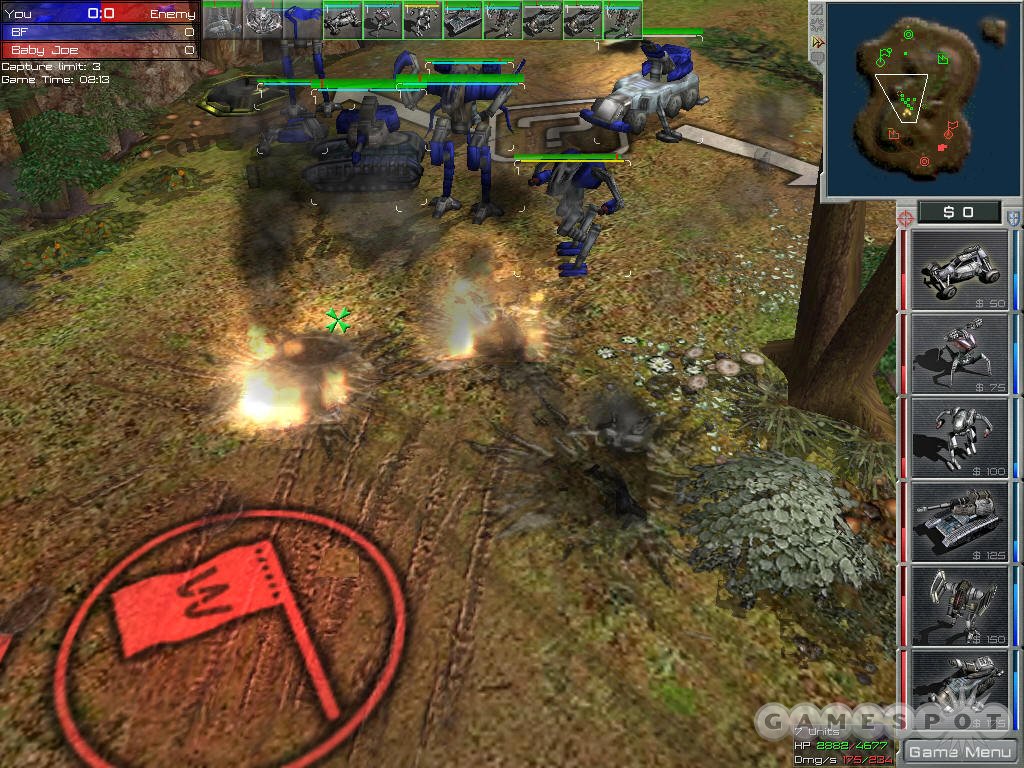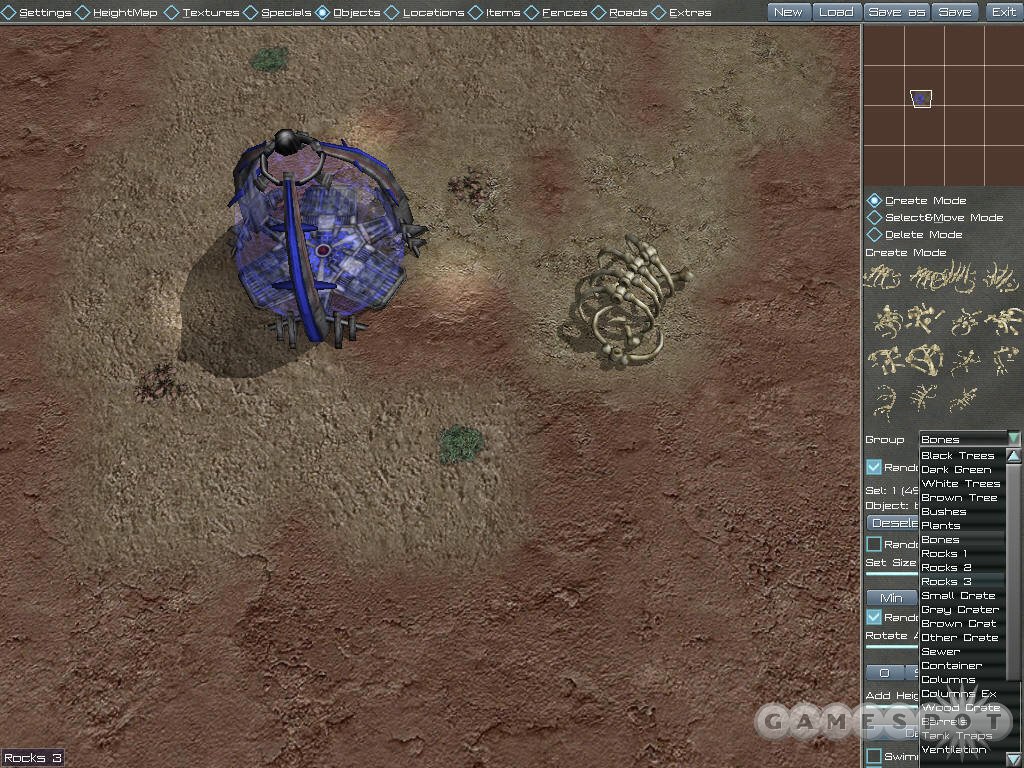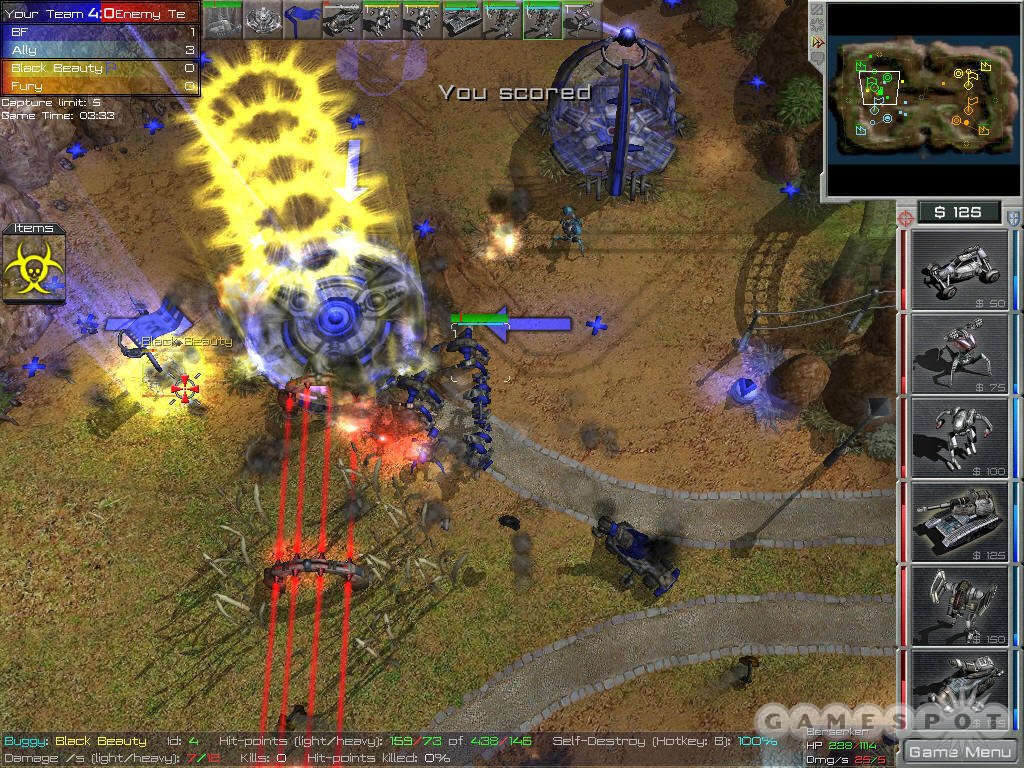Arena Wars doesn't have a real story, a coherent setting, or memorable units. Its music is mediocre, and its voice-overs are cheesy and derivative. Its pacing, controls, and AI all need work. For all its faults, though, Arena Wars manages to offer up clever gameplay that merges elements of shooters and real-time strategy games into a fresh, action-packed whole.

Arena Wars takes cues from team shooters like Unreal Tournament and Quake III, adopting a bit of their in-your-face attitude. More importantly, it adopts shooter-style power-ups and game modes, such as capture the flag, bombing run, and double domination. Arena Wars boasts some of the defining features of RTS games, too--for example, you control multiple units at once from an overhead view while defending a base. Unlike in most RTS games, though, you don't actually build your base, but simply receive it ready-made. Only one of your main buildings, a power generator, can be destroyed, but after a little downtime, a new one appears without any effort on your part.
You don't have to worry about worker units or resources, since there are none. All units are geared solely toward duking it out with the enemy, and you begin right away with a pool of $1,000 for unit purchases. The pool can never rise above $1,000, but when one of your units is destroyed, you instantly get back the money that you originally spent. There are no resources, though you can pick up power-ups that you can use to selectively benefit your units or harm the enemy's.
While these twists on standard RTS gameplay are interesting in their own right, the neatest thing about Arena Wars is the way it successfully brings shooter concepts into the world of real-time strategy. The game's capture-the-flag mode is pretty much what you'd expect: Grab the enemy's flag from his or her base and return it to your own. You can't complete a capture unless your flag is on its stand at the time. If your flag is dropped by the enemy, you simply touch it to return it home. In and of itself, this mode isn't particularly novel, but it's not every day you find CTF smoothly integrated into an RTS. The mode is well balanced, too, with flag carrier units moving slower than normal and unable to execute the special attacks they normally have at their disposal. You can't just perform a mad rush, but rather have to carefully screen your vulnerable flag carrier all the while.
In the bombing run mode, you pick up a bomb and try to place it in the enemy's drop zone. When you do, a timer starts ticking down to the explosion, though this outcome can be avoided or at least postponed if the enemy grabs the bomb and removes it from the zone. The timer will resume its inexorable countdown if the bomb is dropped back into the zone. One of the neat twists in this mode is that you'll need to post more than a few guards near the ticking bomb to prevent enemy units from just marching in and casually removing it from their zone. Yet when the bomb eventually goes off, your defending units might be incinerated in the explosion. This can render you nearly defenseless until you can crank out more units back at home.
In the double domination mode, you have to grab a key and take it to one of two domination points. After you control one point, the key returns to its stand, and you must then reacquire it and use it to occupy the second domination point. You need to control both points simultaneously for 20 seconds--no easy task when the enemy is barreling toward you with its own keys, ready for occupation. To throw a strategic wrench in the works, you can destroy nearby power plants to reset an occupied point to neutral.

You can play these different modes in a series of single-player ladder tournaments with different themes and styles (one-on-one CTF, two-on-two CTF, "insane" difficulty mode, and so forth), or you can play custom games against the AI on multiplayer maps. Arena Wars also includes an easy-to-use map editor for creating your own battlefields. If you want to pit your wits against human opponents, you can play online or LAN matches with up to eight players. The online component of Arena Wars includes a built-in server browser and chat client, as well as a ladder ranking system. Unfortunately, we had problems finding enough players online, and we also had trouble with dropped connections, lag, and bugs. When everything works, though, the multiplayer can be a blast, with exciting action and surprise strategic twists.
To battle the enemy, online or off, you can create six different types of units in any number and combination that you can afford with your $1,000. Each side has access to identical units that differ only in team color, which cuts down on replay value but at least ensures an even playing field. Units include fast but weak buggies, mechs of various sorts, slow but heavily armed tanks, and mobile artillery units that need to stop and deploy before firing. Combat essentially works on a rock-paper-scissors model, with each unit particularly good against one type of unit but particularly susceptible to another type. There doesn't seem to be any clear reasoning behind some of these relationships, and too many units seem like slight variations on the same theme--not a good thing when there are only six different unit types.

The unit AI is iffy, too. Vehicles don't act very wisely, often failing to adequately defend themselves and sometimes getting snagged on each other. The game lacks advanced unit selection and behavior controls, and the pace is quick and unalterable. As such, basic combat can sometimes feel like a simple matter of slugging it out wildly until something blows up. On the bright side, Arena Wars supplies tactical depth through other means. Each unit boasts a special ability like fast kamikaze attacks or teleporting, the latter of which can be great for circumventing hills or making surprise attacks from the rear. You can also upgrade units at special towers on some maps, for a price.
On every map, you can also grab power-ups imaginatively referred to as "items." You can store up to five items in a queue to be activated when you choose. Items let you temporarily boost the armor of a surrounded unit, for example, helping it survive until the cavalry arrives. Or you can boost a unit's speed by 50 percent for 20 seconds, helping it escape pursuing enemies or grab your dropped flag and return it to your base. Just as importantly, you can negatively affect enemies with certain items. You can temporarily cause a unit's weapons to turn on itself, for example, or you can launch an asteroid attack on a group of enemies. The key is to try to keep track of all the combatants during the chaotic battles and make sure you use the right item at the right time on the right unit. If you use items wisely, you can dramatically shape the course of a match.
You'll fight on well-balanced maps with different themes and sizes. The maps' graphics are attractive, if lamentably generic. The landscapes are odd, nonsensical mishmashes of crumbling Greek columns, streetlights, and futuristic electric fences. The units look bland, and some can be hard to differentiate at a glance. Parts of the interface still appear in the developer's native German. Nevertheless, the visuals are enlivened by swaying trees, wonderfully rendered ocean waves, brilliantly colored weapons fire, ejected shell casings, blast marks on the ground, nuanced terrain textures, and more.

The audio features plenty of loud, arcadelike sound effects to help ratchet up the excitement. Forgettable techno tunes and silly voice-overs really mar Arena Wars, though. The mispronounced or outright dumb unit responses seem to be the result of sloppiness on the developer's part: "I'll be back" and "No problemo" are about as unoriginal as you can get, and the announcer's exclamations of "Double kill!" and "Denied!" might smack of being too derivative of Quake III or Unreal Tournament.
Arena Wars could certainly have benefited from more style. As it is, it doesn't really have any unique style at all. The gameplay needs tweaking, too. The way your units tend to wander off and do their own (wrong) thing can be annoying, and the combat can feel a little too fast or chaotic at times. Arena Wars nevertheless manages to rise above these serious problems to offer fresh, fun gameplay that can challenge you both strategically and tactically.